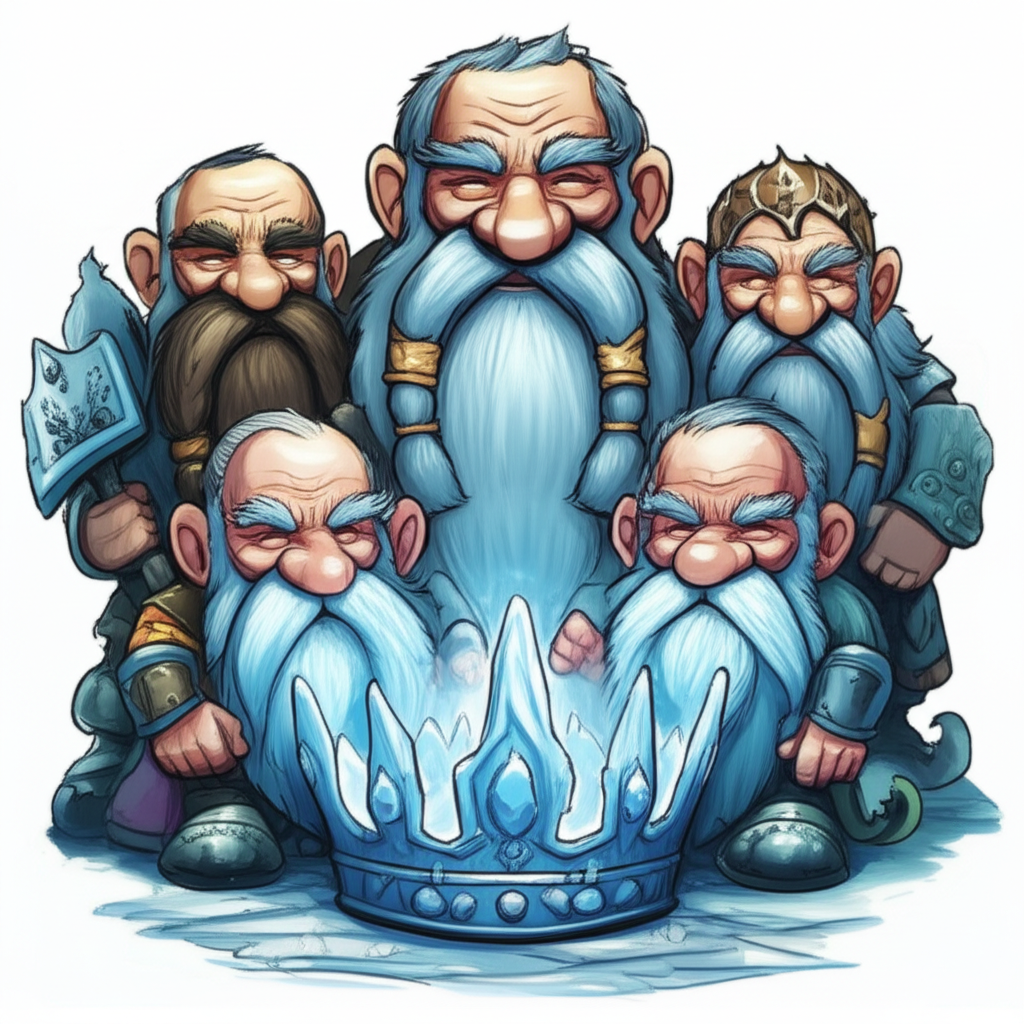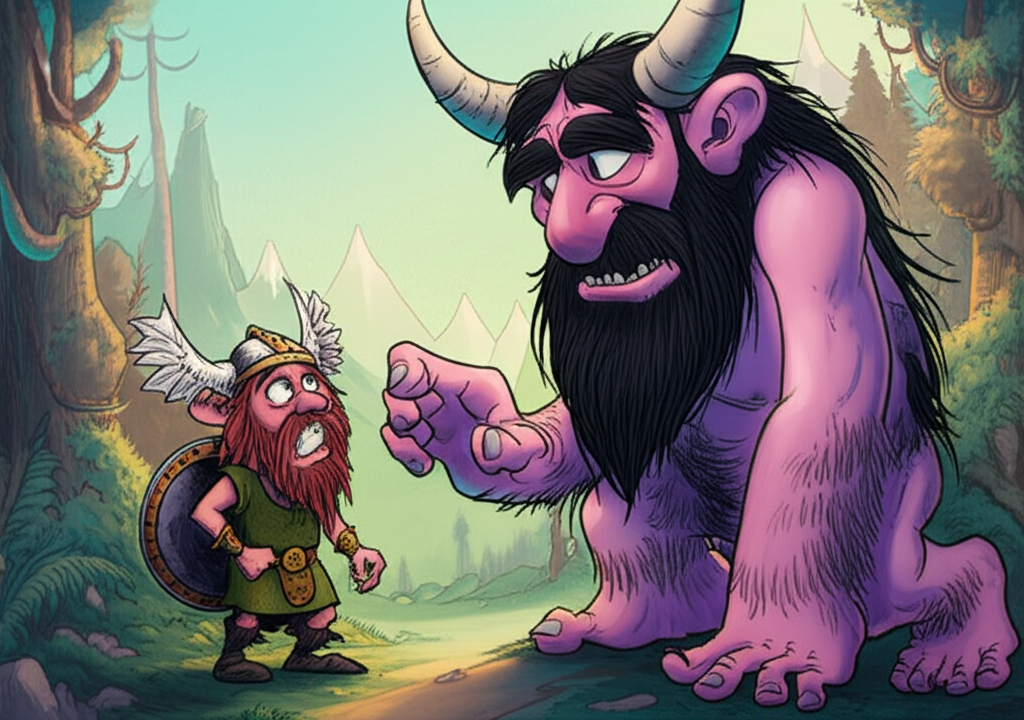
Across the rugged, windswept landscapes of Northern European folklore, particularly within the rich tapestry of Germanic and Norse mythology, tales of stout, earth-dwelling beings known as dwarves have long been woven. These are not accounts of historical fact, but rather the imaginative narratives passed down through generations by ancient peoples who sought to explain the mysteries of the world around them. Among these enduring legends, one particular story speaks of the Dwarves and the enigmatic Crown of Winter, a potent symbol of the season’s power and the enduring spirit of these mythical folk.
The genesis of these tales can be traced back to societies that lived in close proximity to the formidable forces of nature. In the harsh, often unforgiving climes of Scandinavia and parts of Germany, where long, dark winters dominated the year, the natural world held immense power. Life was a constant negotiation with the elements: the deep freeze that could render the land barren, the biting winds that howled like vengeful spirits, and the limited daylight that seemed to shrink with each passing day. These ancient peoples, grappling with survival, often personified these forces. The world was viewed through a lens of animism and polytheism, where natural phenomena, from the mightiest mountain to the gentlest stream, were believed to possess spirits or be influenced by powerful deities and beings. Their stories served as a way to process their environment, to impart moral lessons, and to offer explanations for the inexplicable. The dwarves, with their deep connection to the earth and their resilience in the face of hardship, became a natural element in this imaginative landscape.
The dwarves themselves are depicted in these traditional stories as a race of beings characterized by their stout stature, their incredible strength, and their profound skill in craftsmanship, particularly with stone and metal. They are often described as dwelling deep within mountains and beneath the earth, in vast, cavernous halls illuminated by the glow of their forges. Their physical attributes – broad shoulders, thick beards, and a preference for subterranean living – are often seen as symbolic of their connection to the earth’s bounty and its hidden treasures. They are not depicted as inherently malevolent or benevolent, but rather as a distinct people with their own customs, motivations, and an innate understanding of the deep secrets of the world. Their association with the earth also imbues them with a sense of permanence and unyielding nature, much like the bedrock from which they are said to emerge.
The legend of the Dwarves and the Crown of Winter, though it may manifest in various forms across different oral traditions, often revolves around the dwarves’ deep-seated relationship with the cyclical power of winter. Imagine a time when the first truly biting frost descended upon the land, a frost so profound that it threatened to plunge the world into an eternal, frozen slumber. The stories tell of the great Dwarf-King, a figure of immense age and wisdom, whose beard was like spun silver and whose eyes held the deep, unfathomable knowledge of the earth’s core. This King, or perhaps a collective of the most ancient dwarves, recognized the approaching danger. The Crown of Winter, in this narrative, is not a physical object to be worn, but rather a potent embodiment of winter’s raw, untamed power – a force that, if unchecked, could consume all life.
The dwarves, understanding the delicate balance of the seasons, did not seek to conquer or destroy this power, for they knew that winter, too, had its place. Instead, they sought to understand and to temper it. Their narrative unfolds as a testament to their patience and their intricate knowledge. Deep within their mountain strongholds, they toiled. Their forges, usually aglow with the heat of creation, were banked, and their hammers fell with a different rhythm. They worked with precious metals and stones, not to craft weapons, but to create intricate mechanisms, subtle enchantments, and potent talismans. These were not acts of defiance against the frost, but rather a profound dialogue with it. They sought to capture the essence of winter’s stillness, its clarity, and its dormant strength, but to do so in a way that would not lead to complete annihilation. Through their painstaking efforts, guided by ancient runes and whispered secrets passed down through generations, they were said to have forged a subtle, almost invisible shield, a conduit that would absorb the harshest edges of winter’s fury and channel its life-giving dormancy without succumbing to its destructive potential. This act, this deep communion with the season, is what the legend refers to as their mastery, or perhaps their understanding, of the Crown of Winter. It was not about seizing control, but about achieving a harmonious coexistence.
The symbolism embedded within this myth is rich and multifaceted. The dwarves, representing the steadfastness of the earth and the enduring nature of life, embody resilience. Their connection to the underground speaks to hidden strengths and the resources that lie beneath the surface. The Crown of Winter, on the other hand, represents the formidable power of nature, particularly the seemingly destructive force of winter. It can symbolize the inevitable cycles of decay and renewal, the periods of hardship that test the strength of all living things. The dwarves’ interaction with this power signifies wisdom, patience, and the understanding that true strength lies not in brute force, but in adaptation and balance. It suggests that even the most fearsome forces can be understood and, in their own way, respected and integrated into the natural order. The myth may have served as a way for ancient peoples to find comfort in the face of winter’s harshness, offering a narrative of hope and resilience rooted in the perceived wisdom of these mythical beings.
In the modern world, the enduring appeal of dwarves and their intricate lore continues to manifest across various creative mediums. In literature, authors like J.R.R. Tolkien have significantly shaped our perception of dwarves, imbuing them with a deep love for craftsmanship, a gruff but loyal nature, and a connection to ancient lore and hidden treasures, often echoing the themes found in older myths. Fantasy role-playing games, such as Dungeons & Dragons, have further popularized these characters, allowing players to embody their strength and their connection to the earth. Films and video games often draw upon these archetypes, presenting dwarves as stoic warriors, master artisans, or wise guardians of ancient secrets. The Crown of Winter, while not always explicitly named, often finds representation in the formidable powers associated with winter deities or the challenges posed by extreme cold in fantastical settings. These interpretations, while entertaining and imaginative, are a testament to the enduring power of these ancient stories to spark our creativity and our fascination with the mythical.
It is crucial to reiterate that the tales of the Dwarves and the Crown of Winter are products of human imagination, born from the cultural and environmental contexts of ancient peoples. They are narratives that offer insights into how our ancestors viewed the world, their fears, their hopes, and their understanding of the natural forces that shaped their lives. As Muslims, we recognize that the ultimate Creator and Sustainer of all existence is Allah (SWT). These stories, while rich in cultural heritage and imaginative depth, do not represent divine truth. Instead, they serve as a fascinating window into the human capacity for storytelling, for creating meaning, and for expressing the profound connection between humanity and the world around us, a tradition that continues to inspire and captivate us even today.





